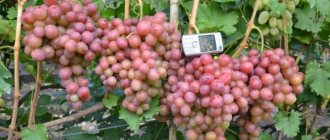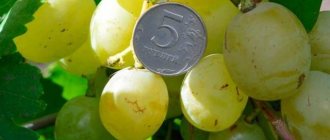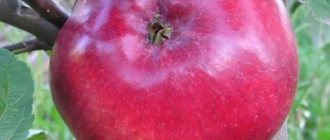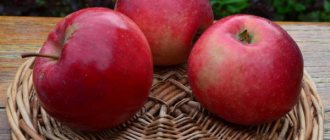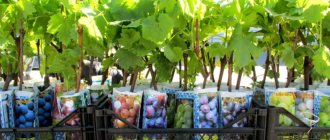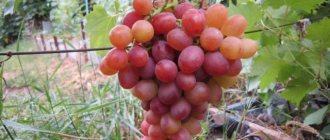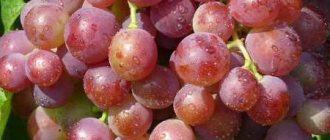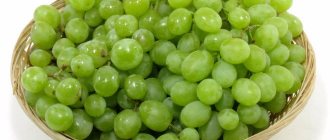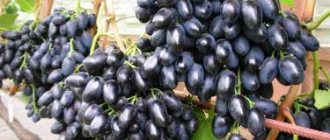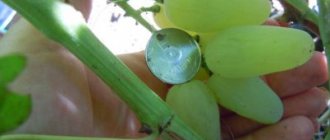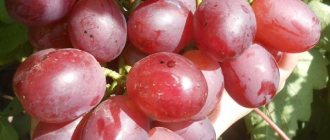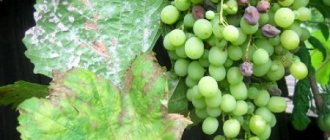Description of the Bazhena variety
The Bazhen table hybrid was created by the Ukrainian breeder V.V. Zagorulko. To obtain a new species, he took as a basis two well-known varieties - “Arcadia” and “Gift to Zaporozhye”. Bazhen grapes are early ripening hybrids. The berries ripen in 100-110 days. The bushes do not grow quickly, the growth of the vine per year is 2-4 meters, but at the same time it matures by 92%. The flowers are bisexual, so pollination by bees is not necessary.
The Bazhen table hybrid was created by Ukrainian breeder V.V. Zagorulko
The bunches can reach a weight of 700-1500 g, and when rationing the grapes - 2.5 kg. They are shaped like an elongated cone, up to 40 cm in length. The berries are very large, beautiful, 20-25 g each. The shape of the berry is ovoid with an elongated nose. The skin is yellow-green, dense. The pulp is fleshy and juicy. The taste is simple but harmonious, without nutmeg. Ripe berries may have notes of cherry, apple or pear in the aroma or taste.
Important!
After full ripening, Bazhen grapes can be yellow-green or simply light green. This worries many buyers. However, even the green berries of ripe Bazhen grapes have a rich, sweet taste!
History of selection
Bazhena is a hybrid obtained 10 years ago as a result of crossing two varieties: Arcadia (also known as Nastya) and Podarka Zaporozhye.
Common agrimony herb - medicinal properties, use and contraindications
The author of Bazheny is the famous breeder V. Zagorulko , who lives and works in the village of Kamenskoye, Zaporozhye region, and over the past decade and a half has created many successful varieties and hybrids, distinguished by large fruits and clusters, as well as early ripening.
Characteristics of Bazhen grapes
Also check out these articles
- Turkey feed
- Autoclave Belarus Lux
- Important tips for choosing a generator for your home or cottage
- Apricot Red-cheeked
The characteristic qualities of the Bazhen grapes, which distinguish it from other varieties and hybrids, are presented below.
Flowers are bisexual, so pollination by bees is not necessary
- Ripening period is early.
- Pollination rate is average.
- Pea peas are rarely observed.
- The berries do not crack when overripe.
- The grapes tolerate changes in temperature and humidity well.
- Frost resistance down to -22 degrees.
- Productivity is high. 25-35 kg of bunches are collected from a bush per season.
- The bunches are suitable for transportation over long distances.
- Product quality is high.
- The sugar content in the composition is 17-19% with an acidity of 6-8 g/l.
Thanks to these qualities, the Bazhen hybrid is in great demand among winegrowers in Ukraine, Russia, Belarus and Moldova.
The shape of the berry is ovoid with an elongated nose. The pulp is fleshy, juicy
Comparison with analogues
Among the early varieties, “Bazhena” is the largest-fruited hybrid. In appearance it resembles the Arcadia variety, but the berries are larger and more elongated. Consider it in comparison with your main competitors.
| Sign | Variety | |||
| Bazhena | Arcadia | Delight | Timur | |
| Ripening period | 105 – 115 days | 115-125 days | 110-120 days | 105-115 days |
| Frost resistance | up to -24C | up to -21ºС | up to -25 °C | up to -25°С |
| Yield per bush | 25 – 30 kg | 30-50 kg. | 30-50 kg | up to 20 kg |
| Bunches | 700g – 1.5 kg | 500-700 g (up to 2 kg) | 500-700 g | 400-600 g |
| Taste | Fruity notes | unobtrusive with light nutmeg | Muscat aftertaste and aroma | nutmeg |
| Color | Lime-amber | white | White | amber green |
| Disease resistance | Average | average | High | above average |
| Shelf life | 1 – 2 months | Few weeks | 2-3 months | up to 2 months |
| Sugar content | 15 – 16% | 14-16% | 19-26% | 17-22% |
| Acidity | 4 – 6 g/l | 6 g/l | 5-9 g/l | 5-6 g/l |
Features of planting the variety
Bazhen table grapes can be grown exclusively in a sunny area on the south side. If there is a lack of sunlight, you will not be able to get large, sweet berries even with abundant feeding! The land can be any kind, as long as it is fertilized. The groundwater level must be low, otherwise the root system may suffer from stagnation of water, and the plant will not be able to fully develop.
Important!
After planting Bazhen grapes, the first, large harvest can be expected in 2-3 years.
It is best to plant Bazhen grapes when the bush is dormant. The planting hole is made with an average diameter of 80 cm and a depth of 75-80 cm. The distance between the holes is 1.5-3 meters. If the groundwater level is high, it is necessary to arrange a drainage system and pour some soil on top. Before planting, the roots of the bush are inspected for the presence of pests, rot, and other diseases. It is recommended to shorten very long roots. Some gardeners treat them with a growth stimulator.
Bazhen table grapes should be planted exclusively in a sunny area on the south side
The land for planting is fertilized with humus (compost), superphosphate in combination with potassium sulfate. If the soil is not fertilized, the survival rate of the bushes will decrease. The grapes are planted very carefully so that the root system is not damaged. After planting, the soil is compacted with hands, watered and, if necessary (if the soil has settled), more soil can be added.
Caring for Bazhen grapes
We recommend reading our other articles
- The best breeds of geese
- Chickens of the Adler silver breed
- Bordeaux mixture
- Meat rabbits
Bazhena is undemanding when it comes to care. To obtain a normal harvest, basic measures must be followed.
- A support is installed under each bush. It must be made from high-quality material so that it does not fall under the weight of the vine.
- Watering is carried out with a frequency of 1 time every 3-7 days. When filling the berries, watering is needed more frequently, but after the berries have reached their final size and began to fill with sugar, less water is added so that the taste is not watery. 1-2 weeks before harvest, you can stop watering the crop altogether.
- Mulching is not necessary, but recommended. This grape variety consumes a lot of liquid, and mulching allows you to save water consumption. You can choose peat, humus or straw as mulch. Sometimes sawdust is also used.
- Feeding is done several times during the season. Before flowering and after the buds fall off, the NPK complex is applied. When the fruits ripen, only potassium and phosphorus are added. The easiest way is to do root and foliar, liquid fertilizers - they are absorbed faster and better. If organic matter is introduced, then it can simply be embedded in the soil when loosening it. The best time to add organic matter is September or October (before wintering). Wood ash, as a fertilizer and insect repellent, can be scattered between rows in spring and summer.
Sheltering grapes for the winter is required in all regions except the southern
Important!
If there are a lot of leaves on the grape bush and they shade the bunches from the sun, it is worth thinning them out. But not all the leaves and not most of them are removed, but only those that cover the berries from the sun's rays.
- Pruning should be done at 8-10 buds - if the bush is pruned very much, it will take a long time to recover.
- Shelter for the winter is required in all regions except the south. If the climate is warm, then there is no need to insulate the vineyard, but if the temperature can drop below -22 degrees, it is better not to risk it. The root zone in the fall should be mulched with straw or peat to a depth of 25-30 cm, the ground part of the bush should be covered with insulating material. This can be done by bending the vine to the ground or simply covering the bush. In winter, if possible, the plant is covered with snow, which is also an excellent “blanket” against frost.
With proper care, the vineyard produces large, high-quality harvests.
Planting in the ground and preparation for it
Bazhena, like any other grape, is a light- and heat-loving plant. For cultivation, choose areas that are well-warmed by the sun. It is advisable to place it on the southern slope of a gentle hill, closer to the top. Any lowlands where melt water stands for a long time in the spring and damp cold air lingers the rest of the time are strictly unsuitable. The grapevine also does not like drafts. Ideally, at some distance (2–2.5 m) from the vine there should be a natural or artificial barrier that would protect it from gusts of wind without shading it. It's good if it's made of stone or brick. Heating up during the day, it will give off heat to the plant at night.
The place for the vine is chosen so that the area is well warmed by the sun and the plants have enough area for nutrition
Bazhena does not have any special requirements for soil quality. The ideal option for grapes is black soil, but it can also ripen on relatively poor soils. In this case, it is desirable that the substrate be light and allow water and air to pass through well. Acid-base balance - 5.5–7.0. The root system of the plant is powerful, so groundwater should be located at least 4–5 m from the soil surface. Otherwise, the development of root rot is very likely.
Bazhena’s vines are vigorous, so a minimum of 5 m is left between plants when planting. The same distance is maintained between rows of plantings. It is even better to increase it to 6–7 m, if the area of the site allows. The distance to the nearest fruit trees should be at least 5 m, and to the bushes - about 2 m.
At the same time, space should be provided for installing a trellis. Otherwise, the vines will not withstand the load. The simplest option is metal or plastic pipes of small diameter dug into the ground with wire stretched across them in several parallel rows. The lower one is located at a distance of 50–70 cm from the surface of the earth, then 120–140 cm and 180–220 cm. The height of the trellis allows you to adjust the height of the grape bush, which greatly facilitates its care.
Bazhena can be planted in both spring and autumn. The first option is the only one possible for regions with a continental climate. It is impossible to predict when frost will occur there. And during the summer the plant will definitely have time to adapt to new living conditions. The optimal time for the procedure is the first half of May. By this time the air should warm up to at least 15ºС, and the soil at a depth of about 10 cm should warm up to 10–12ºС.
Autumn planting is practiced mainly in the homeland of the hybrid. It is carried out from early September to mid-October. You need to be absolutely sure that there are at least two months left before the cold weather. As practice shows, grapevines planted in the spring develop faster, but in the fall there is a wider choice of varieties.
Two-year-old grape seedlings take root best. High-quality planting material has white or cream-colored roots when cut, green shoots, smooth, elastic, evenly colored bark, not flaking or wrinkled, without spots resembling mold or rot. It is necessary to have several growth buds that should not fall off when touched. Seedlings are purchased exclusively in specialized stores, nurseries, and other trustworthy places. Only in this case can the quality of planting material be guaranteed.
Grape seedlings are purchased only from trustworthy suppliers
The planting pit is prepared at least 3–4 weeks before the planned procedure. And when planting in spring, generally from the fall. Bazhena’s root system is powerful, the optimal depth is 80–90 cm. The diameter is about the same. Sometimes amateur gardeners plant grapes in trenches about 50 cm deep, but this option is practiced quite rarely.
The landing pit is prepared as follows. At the bottom, a layer of drainage at least 10 cm thick is required. Suitable materials are expanded clay, clay shards, pebbles, broken bricks, and so on. You also need to remember to dig in a plastic pipe of small diameter - through it the plant will receive water. This is the optimal method of watering for grapes. The length of the pipe should be such that after filling the hole it protrudes 10–15 cm above the soil surface.
At the bottom of the planting pit for grapes, a layer of drainage is required so that water does not stagnate at the roots
About 10 cm of fertile turf soil is poured onto the bottom of the pit, about the same amount of a mixture of humus and peat chips (1:1) with the addition of 120–150 g of simple superphosphate, 80–100 g of chlorine-free potassium fertilizer and 150–200 g of dolomite is poured on top. flour. This needs to be repeated again and the resulting “layer cake” should be covered with regular soil. Then 50–70 liters of warm water are poured into the hole and left covered with any waterproof material. Mineral fertilizers can be replaced with wood ash (approximately 0.5 l). A very light sandy substrate is mixed with powdered clay, and coarse sand is added to heavy soil.
Humus is a natural remedy for increasing soil fertility
The procedure for planting grape seedlings in the ground is no different in complexity:
- A day before the procedure, the seedlings are removed from the containers, examined, and healthy roots are shortened by about 3–4 cm. Their length should not exceed 15–18 cm. Dried and blackened ones are cut off completely. Then they are soaked in a solution of any biostimulant with the addition of several crystals of potassium permanganate. You can use both store-bought preparations (Epin, potassium humate, Zircon) and folk remedies (aloe juice, honey, succinic acid). This is necessary to strengthen the plant’s immunity, disinfection and prevention of fungal diseases.
- 3–4 hours before planting, the roots are dipped in a slurry of powdered clay diluted with water with the addition of any vermicompost-based fertilizer (5–7 ml per liter). The consistency of this mass should resemble not too thick sour cream. They give it time to dry.
- About an hour before planting, the soil in the planting hole is watered abundantly. When the moisture is absorbed, a small mound is formed at the bottom. The seedling is placed on its top, straightening the roots so that they are directed downwards and not sticking up and to the sides. It should be inclined at an angle of 40–45º. The exception is cuttings up to 25 cm long; they are placed vertically. The “heel” of the root is oriented to the south, the growth buds are oriented to the north.
- The hole is gradually filled with soil, filling it in small portions. The seedling needs to be shaken periodically, and the soil must be carefully compacted with your hands to avoid the formation of air “pockets”. During the process, be sure to ensure that the root collar is not covered. It should be located 5–7 cm above the ground surface.
- Having filled the hole to the end, the soil is once again well compacted. The grapes are watered abundantly (30–40 l). When the water is absorbed, a near-trunk circle with a diameter of about 60 cm is mulched with peat chips, rotted sawdust, humus, and freshly cut grass. You can also cover it with black plastic film. Existing shoots are shortened, leaving 3–4 growth buds. Until the seedling begins to grow, it is covered with a cut plastic bottle.
Planting grapes in the ground differs little from a similar procedure for other seedlings
Video: how to plant a grape seedling correctly
Diseases and pests of the Bazhena variety
The Bazhen hybrid exhibits stable immunity to many fungal infections (it does not get sick from mildew and phylloxera with proper care at all). If you carry out preventive treatments with fungicides 2-3 times a year, problems with diseases will never arise. Among the preparations that are recommended by gardeners, we can highlight “Topaz”, “Falcon”, “Strobi”, “Skor”.
Medicines recommended for grape diseases
Soft leaves and sweet berries attract many pests. Very often, bushes are inhabited by slugs, aphids, and mites, and the berries are spoiled by birds and wasps. What to do with them? Problems with pests when growing Bazhen grapes appear in 9 cases out of 10, no matter what kind of prevention is carried out. But, in order to minimize losses, you can use insecticides like “Aktellik”, “Fufanon”, “Zolon” to treat the bushes, and use special nets for bunches or repellers or baits for wasps and birds.
Harvesting and processing
Harvesting takes place from late July to mid-August. The bunches should be collected immediately after ripening. At this time, the berries are already sugary and crunchy. If you keep them on the vine, the skin will become harsh and the flesh will become very soft, reducing their keeping quality and transportability.
Important!
Bazhen grapes can be stored on the vine for a long time and do not fall off, but it is better to collect the bunches immediately after ripening.
The grapes should be picked immediately after ripening.
The crop is most often used for fresh eating. You can also use the berries for preparing summer desserts, juice, and canning. But these grapes are usually not selected for making wine.
Reviews about the Bazhena grape variety
As can be seen from the description, Bazhen grapes are a worthy representative of the species. But what is the opinion of gardeners about this hybrid?
- Alexander Melnik : “On my plot, Bazhena ripens 1.5 weeks earlier than Arcadia, which grows next door to it. The clusters are large, the berries are also large, very tasty. The variety is pleased with the uniform ripening of the shoots and not very fast growth (fewer problems with pruning). I got sick no more than 2 times in 5 years of cultivation, but after applying fungicides I recovered very quickly. Problems sometimes arise with pests, but this is the case with all types of grapes - you just need to do preventative treatments. I’m very pleased with the hybrid, I can recommend it for growing.”
- Alena Mokhova : “I planted Bazhen grapes 3 years ago. Last summer I harvested my first harvest. So that it would not be too heavy for the bush, I left 3 bunches on the bushes for testing. I am more than satisfied with the taste and quality of the harvest. The grapes are sweet and big – I might start selling them in the future. It does not require special care - pruning, watering, fertilizing. I haven’t been sick yet, but they treat aphids several times a season - there are a lot of them on the site, I’m afraid Bazhena will get it too.”
- Mikhail Voloshko : “When I first tried Bazhen grapes, I immediately ordered a couple of bushes for planting. I've been growing it for 4 years now. It impresses with both the size of the berries and the taste. Although not nutmeg, it is very sweet, just like table grapes should be! The harvest does not lie dormant for a long time - the whole family eats it with great appetite. Next year I will plant 3 more bushes.”
Photo gallery
Appearance
The morphological and technical features of the hybrid are as follows:
Application of grapes
Bazhena is a table grape variety of white grapes. The main use of the crop is fresh consumption. The taste of the berries cannot be called ideal, but for an extremely early and unpretentious hybrid they are at a decent level. The balance of sweetness and sourness in the fruits is maintained; they have a pleasant aroma reminiscent of cherries, and in the overripe stage - apple or pear. At the same time, the skin of the berries is not very dense, it is easy to bite and does not interfere with the enjoyment of the taste of the juicy and fleshy core.
Bazhena can also be used for making homemade wine, juice, as well as preservation (jam, jam, compotes), although technical varieties are still more suitable for such purposes - it is a pity to send early-ripening and large-fruited white grapes for harvesting.
Advantages and disadvantages
- During the short period of its existence, Bazhena managed to fall in love with winegrowers and ordinary summer residents thanks to the following advantages:
- ultra-early ripening (in this indicator, the hybrid is at least 7–10 days ahead of Arcadia), which makes it possible to grow the hybrid in regions where the summer is not very long;
- easy rooting of the vine and its rapid growth;
- no problems with pollination due to bisexual flowers;
- large fruits (almost twice as large as the Odessa variety) with no tendency to peas, dry out and crack;
- high resistance to fungal infections (on a 5-point scale, immunity to gray rot is rated at “5”, resistance to other types of rot, oidium, downy mildew - at “3.5”);
- simplicity and low cost of care;
- the ability to withstand temperature changes, as well as a lack or excess of moisture in the soil without loss of taste;
- good transportability of the crop and excellent commercial qualities, mainly due to large clusters with identical berries and their tight holding on the stalks;
- low losses from wasp attacks (due to the specific aroma of the berries);
- long shelf life of the crop (fully ripened bunches can remain on the vine for 2–3 weeks without external signs of spoilage; moreover, even lying on the ground with unsuccessful gartering or pruning, the grapes can ripen and retain their presentation).
- Parameters by which Bazhena is inferior to standard table varieties of white grapes:
- less high and stable yield;
- the need for pruning and pinching;
- average frost resistance, the need for wrapping and digging;
- the taste is high, but not impeccable (on a 5-point scale, the hybrid received a rating of “4.5”);
- the color of the fruit is not golden-honey, like more expensive varieties, but greenish, especially at the ripening stage;
- thickening of the skin and liquefaction of the pulp when overripe (it is recommended to harvest the crop in the early stages of technical maturity);
- instability to aphids, snails (due to soft leaves) and grape itch.
Proper care of the Pachira Aquatica (Aquatic) plant at home for a houseplant, photos and disease control
